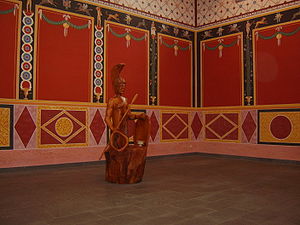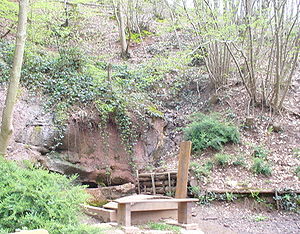
Lenus
Encyclopedia


Gaul
Gaul was a region of Western Europe during the Iron Age and Roman era, encompassing present day France, Luxembourg and Belgium, most of Switzerland, the western part of Northern Italy, as well as the parts of the Netherlands and Germany on the left bank of the Rhine. The Gauls were the speakers of...
, where he was almost always identified with the Roman
Roman mythology
Roman mythology is the body of traditional stories pertaining to ancient Rome's legendary origins and religious system, as represented in the literature and visual arts of the Romans...
god Mars
Mars (mythology)
Mars was the Roman god of war and also an agricultural guardian, a combination characteristic of early Rome. He was second in importance only to Jupiter, and he was the most prominent of the military gods worshipped by the Roman legions...
. He was an important god of the Treveri
Treveri
The Treveri or Treviri were a tribe of Gauls who inhabited the lower valley of the Moselle from around 150 BCE, at the latest, until their eventual absorption into the Franks...
tribe, who had large sanctuaries at medicinal springs at Trier
Trier
Trier, historically called in English Treves is a city in Germany on the banks of the Moselle. It is the oldest city in Germany, founded in or before 16 BC....
and the Martberg by Pommern
Pommern, Rhineland-Palatinate
Pommern is an Ortsgemeinde – a municipality belonging to a Verbandsgemeinde, a kind of collective municipality – in the Cochem-Zell district in Rhineland-Palatinate, Germany...
in what is now Germany
Germany
Germany , officially the Federal Republic of Germany , is a federal parliamentary republic in Europe. The country consists of 16 states while the capital and largest city is Berlin. Germany covers an area of 357,021 km2 and has a largely temperate seasonal climate...
. Two dedications to him are also known from southwestern Britain
Roman Britain
Roman Britain was the part of the island of Great Britain controlled by the Roman Empire from AD 43 until ca. AD 410.The Romans referred to the imperial province as Britannia, which eventually comprised all of the island of Great Britain south of the fluid frontier with Caledonia...
(Chedworth
Chedworth Roman Villa
Chedworth Roman Villa is a Roman villa located at Chedworth, Gloucestershire, England. It is one of the largest Roman villas in Britain.-Siting:...
and Caerwent
Caerwent
Caerwent is a village and community in Monmouthshire, Wales. It is located about five miles west of Chepstow and eleven miles east of Newport, and was founded by the Romans as the market town of Venta Silurum, an important settlement of the Brythonic Silures tribe. The modern village is built...
). Edith Wightman characterizes him as “one of the best examples of a Teutates, or god of the people, equated with Mars—protector of the tribe in battle, but also [...] bestower of health and general good fortune” (p. 211). His sanctuary ‘Am Irminenwingert’ at Trier had a large temple, baths, smaller shrines and a theatre; that on the Martberg also included a large variety of buildings, probably including rooms for health-seeking pilgrims to stay. Despite his associations with healing, Lenus Mars is depicted classically as a warrior with Corinthian helmet in a bronze statuette from the Martberg.
His name most often appears in inscriptions as ‘Lenus Mars’, rather than ‘Mars Lenus’ as would be expected from other most syncretized names. At Trier, Lenus Mars's divine partners were the Celtic god Ancamna
Ancamna
In Gallo-Roman religion, Ancamna was a goddess worshipped particularly in the valley of the Moselle River. She was commemorated at Trier and Ripsdorf as the consort of Lenus Mars, and at Möhn as the consort of Mars Smertulitanus...
and the Roman Victoria, as well as the Xulsigiae
Xulsigiae
In Gallo-Roman religion, the Xulsigiae were triple goddesses worshipped at the healing-spring shrine in Augusta Treverorum . Edith Wightman suggests that they "may be local nymphs of the spring"; on the other hand, she also links their name to that of the Suleviae, whom she characterizes as...
, who are perhaps water nymphs. An inscription from Kaul in Luxembourg
Luxembourg
Luxembourg , officially the Grand Duchy of Luxembourg , is a landlocked country in western Europe, bordered by Belgium, France, and Germany. It has two principal regions: the Oesling in the North as part of the Ardennes massif, and the Gutland in the south...
appears to invoke Lenus Mars ‘Veraudunus
Veraudunus
Veraudunus is the name of a Celtic god known only from two votive inscriptions found in Luxembourg. One of these inscriptions suggests that ‘Veraudunus’ may have been an epithet of the important Treveran god Lenus Mars...
’ along with the Celtic god Inciona
Inciona
Inciona is a little-known Celtic goddess of the Treveran region. Her name is recorded as one of a pair of deities on two votive inscriptions from Luxembourg....
.
Lenus was not the only Celtic god identified with Mars by the Treveri; others, such as Iovantucarus
Iovantucarus
Mars Iovantucarus was a Celtic god who was associated with the Treveran healer-god Lenus Mars at his sanctuary at Trier. The name reflects the deity's function as a protector of youth, and the temple was visited by pilgrims who often brought with them images of children, often depicting as holding...
(apparently a protector of youth), Intarabus
Intarabus
Intarabus was a Gaulish god in the pantheon of the Treveri and some neighbouring peoples. His name is known from nine inscriptions from a relatively compact area in what are now Belgium, Luxembourg, western Germany and eastern France. He may have been the tutelary deity of one of the three pagi of...
, Camulos, and Loucetios
Loucetios
In Gallo-Roman religion, Loucetios was a Gallic god invariably identified with the Roman Mars. About a dozen inscriptions in his honour have been recovered, mainly from eastern Gaul, with a particular concentration among the Vangiones . Mars Loucetios is often accompanied by Nemetona...
were identified with Mars and perhaps, by extension, with Lenus. His name occasionally appears as ‘Mars Laenus’; the more usual form ‘Lenus Mars’ is accompanied by the epithets Arterancus and Exsobinus on one inscription each.
In Britain, Mars Lenus may have been identified with Ocelus Vellaunus
Ocelus
Ocelus is a Celtic god known from three inscriptions in Roman Britain. He is twice invoked on dedications at Caerwent: one stone is the base of a state of which only a pair of human feet and a pair of goose feet survive. The invocation is to Mars Lenus or Ocelus Vellaunus and the "numen" of the...
, on the evidence of this inscription on the base of a statue:
- DEO MARTI LENO SIVE OCELO VELLAVN ET NVM AVG M NONIVS ROMANVS OB IMMVNITAT COLLEGNI D D S D GLABRIONE ET HOMVLO COS X K SEPT
- To the god Mars Lenus or Ocelus Vellaunus and to the NumenNuminaNumen is a Latin term for a potential, guiding the course of events in a particular place or in the whole world, used in Roman philosophical and religious thought...
of the AugustusAugustus (honorific)Augustus , Latin for "majestic," "the increaser," or "venerable", was an Ancient Roman title, which was first held by Gaius Julius Caesar Augustus , and subsequently came to be considered one of the titles of what are now known as the Roman Emperors...
, M. Monius Romanus dedicated this from the privilege of the college during the consulship of Glabrio and Homulus ten days before the Calends of September.

